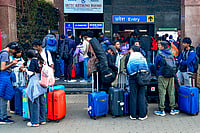- Focus on education and infrastructure development starting December;
- Initiate health awareness campaigns and set up primary healthcare centres;
- Address unemployment. Microcredit assistance, self-help women group initiatives starting January 2007.

The note also talks of channelising corporate social responsibility to the village by implementing a novel conceptualise-initiate-transfer model wherein project ownership is transferred to corporates after a phase-wise completion. The jargon apart, it means the company investing in a project takes on the responsibility of running it on a no-profit basis.
Second-year student Akash, along with colleagues Dr Rajiv Goel, a veterinary doctor, and Satyendra Chaudhary, will be overseeing how the concept note works on the ground. They are trying to convince the villagers to show a little initiative instead of seeking help. "We find lack of resources a major hurdle here and are trying to get companies to offer credit to the villagers," says Goel. Education is another lacuna they find, and three days of the week, the students teach children who cannot afford a formal education.
One reason perhaps why students here were enthused by the project is that IIM-L sets aside Rs 5 lakh to train students from socially backward communities. As Anup Upadhyay, a student from Jharkhand, points out, "Many students come from a humble background which places us in a unique position to understand the problems of rural India." Students like him have struck a chord with Chakarpurva villagers. Even the sceptics among them now see hope. Though Singh's set a roadmap till 2008—the year he demits office—villagers can already sense change. Says Ram Singh, 75, "I know the students will change the shape of our village. I know they can do it." It's a confidence IIM-L students are making sure does not get waylaid.






















